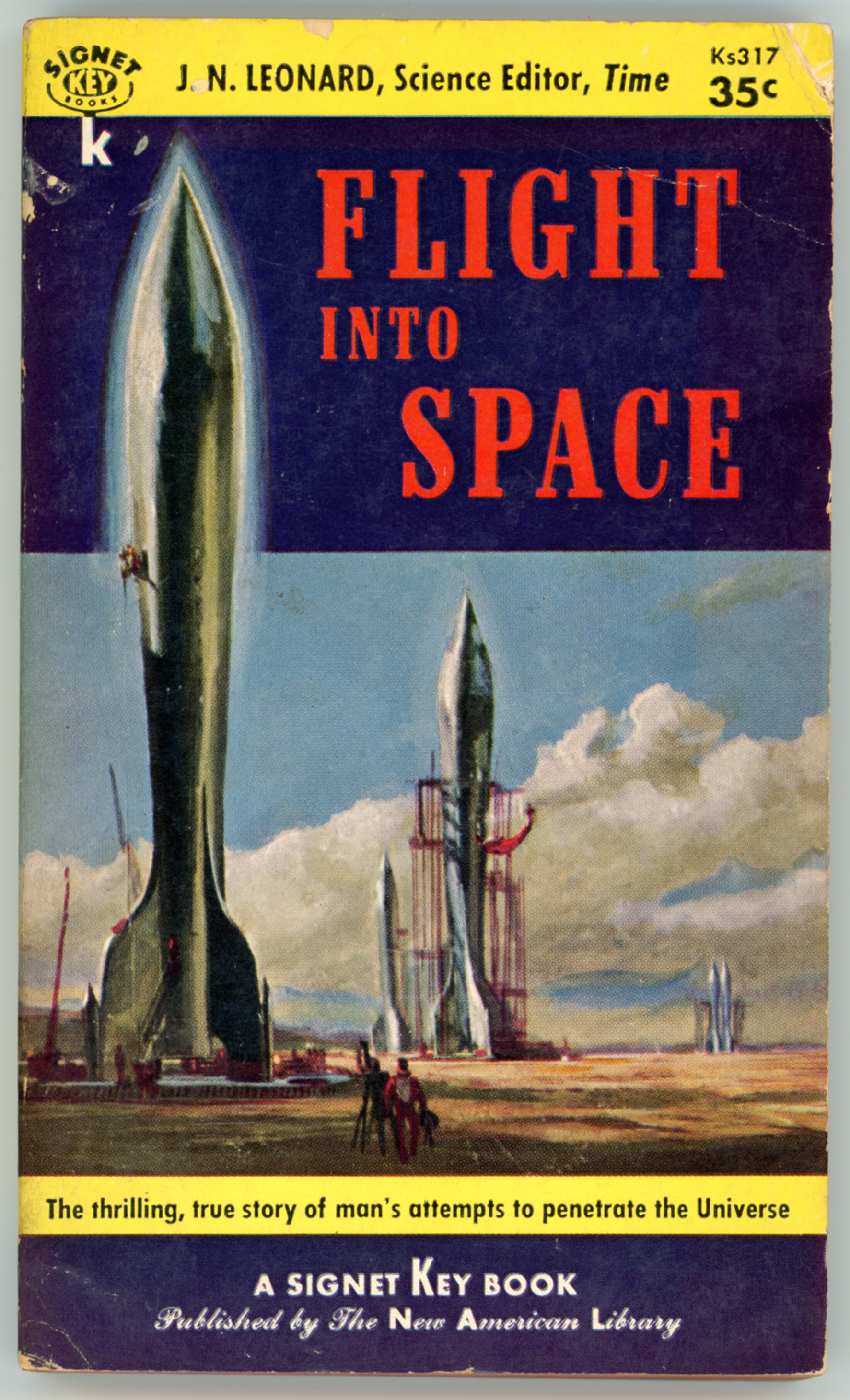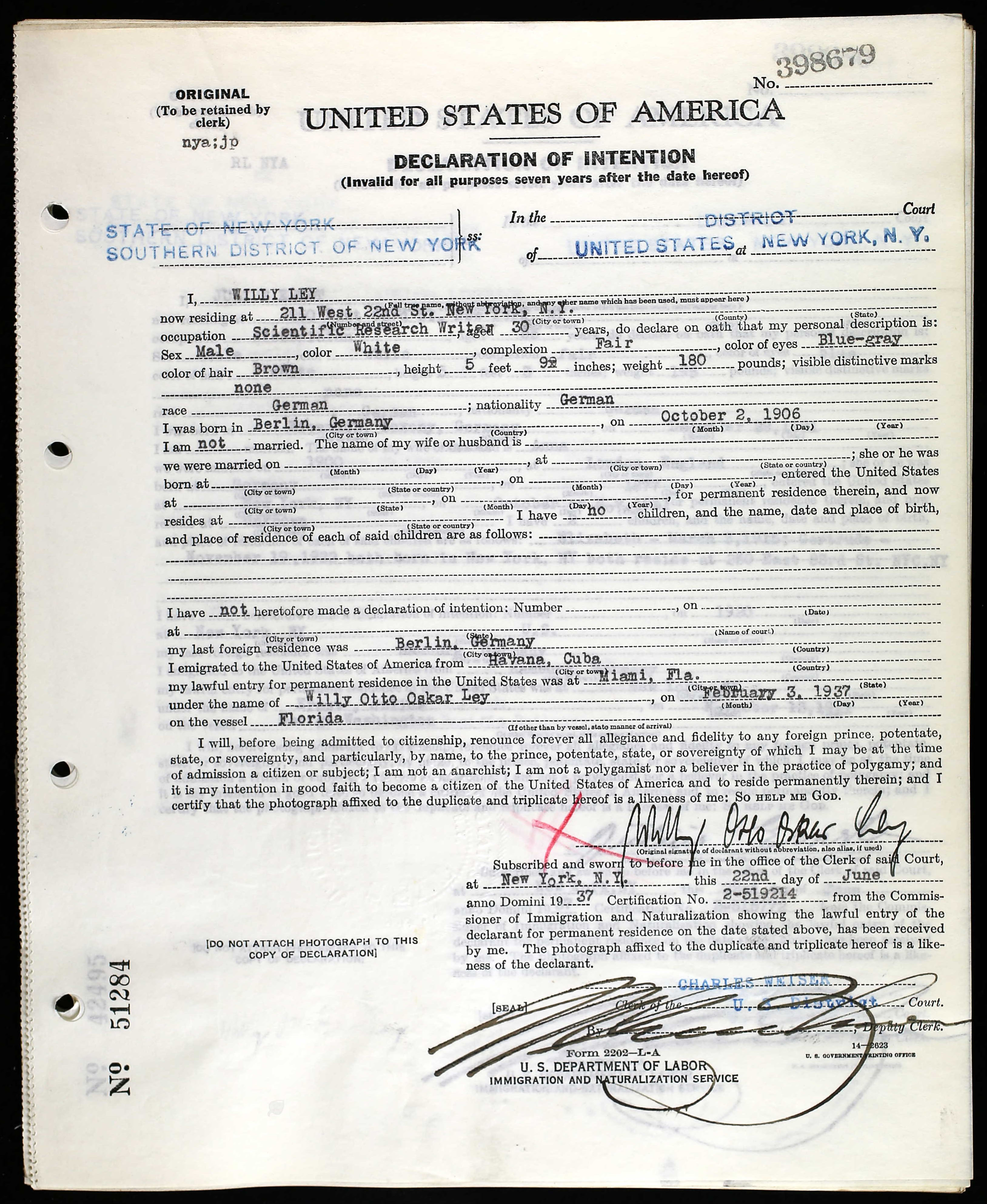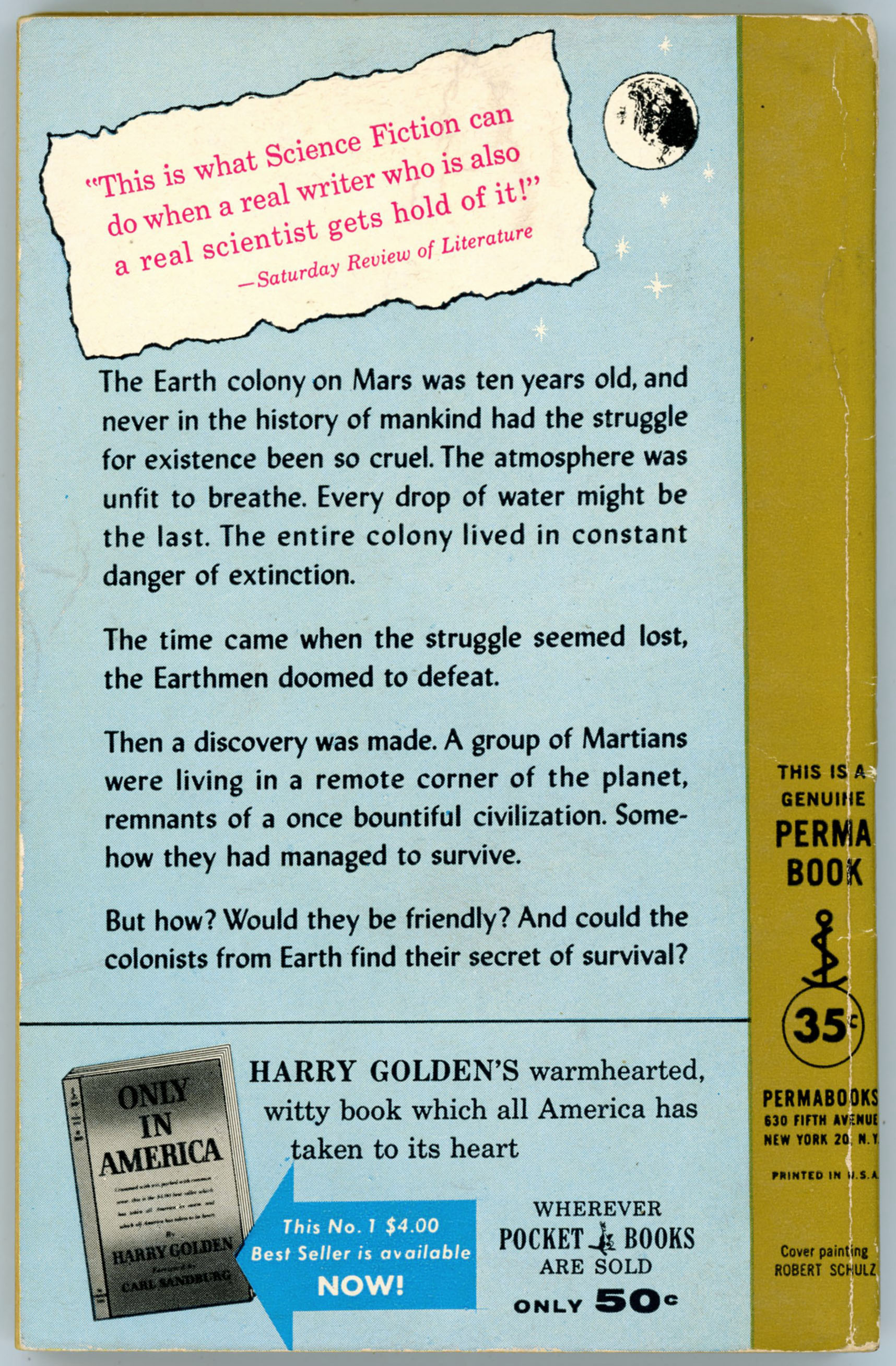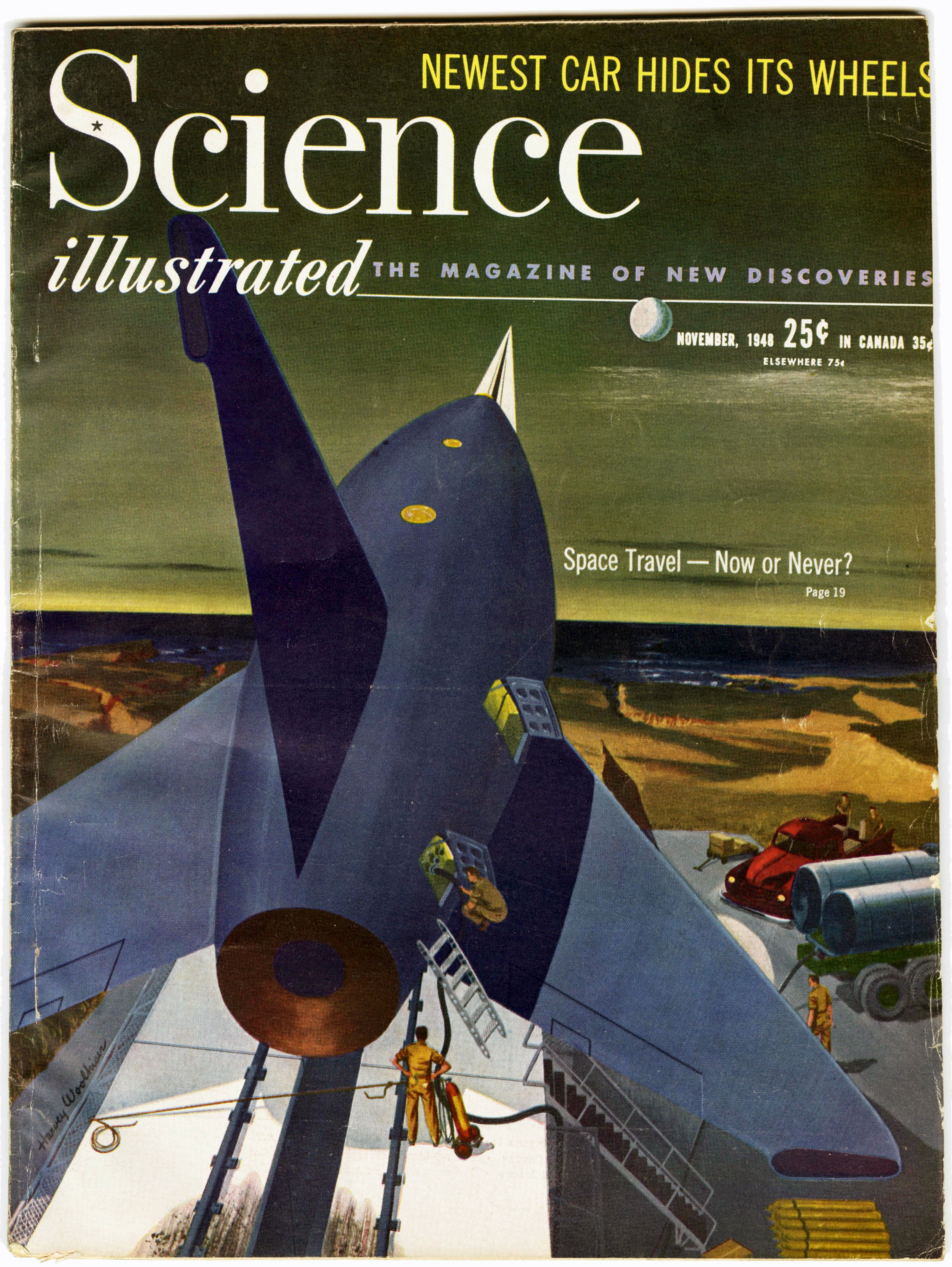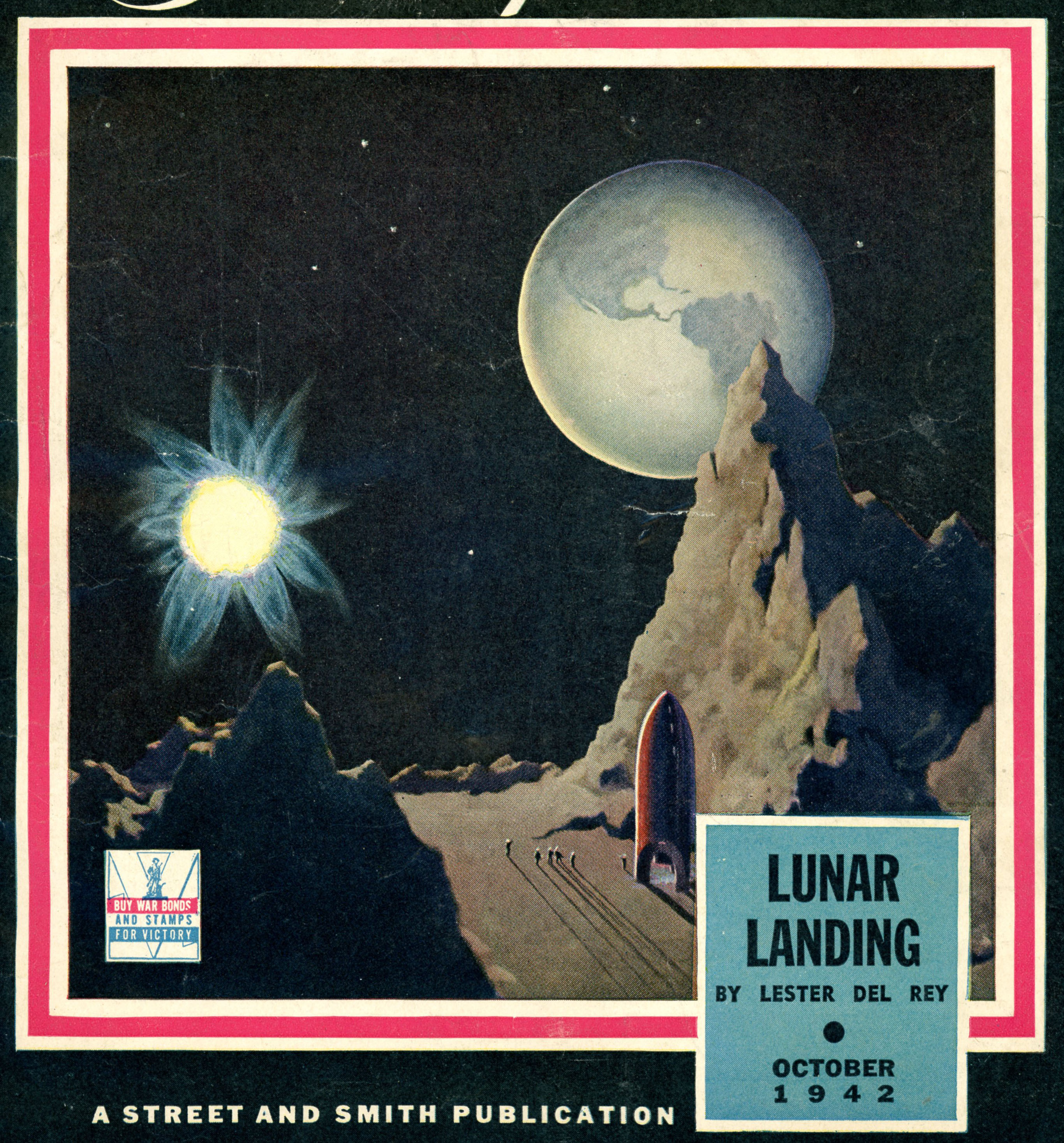In art; as much as in literature; as much as in “life”, there are patterns and coincidences. Some turn out to be illusory, while others are as real as they are telling.
Years ago, shortly after The Eye of Sauron (a.k.a. “Oogle”) enabled search results to display images (a feature since then vastly enhanced in terms of capability and selectivity) I searched for images using the terms “science fiction”, “science fiction art”, “science fiction magazines”, “astronaut”, “space exploration”, and then, by artists’ names – for example “Virgil Finlay” – to see what could be found in the way of relevant art and illustration, regardless of original format or venue. Though the results greatly varied depending upon search criteria and time interval, a subtle repetitiveness emerged and has persisted among the sets of images returned by Google (and now, DuckDuckGo).
Two recent examples (as in “today-as-I-write-this-post”) are shown below. They show search results for the text string “Virgil Finlay astronaut”, sans filters.
Here’s the results for DuckDuckGo:
 And, the results from The Eye of Sauron (otherwise known as “Oogle”):
And, the results from The Eye of Sauron (otherwise known as “Oogle”):
The search results are obviously very, very (did I say “very”?!) different in terms of the specific images returned, and, the order and “location” of these images as displayed, which I guess this reflects the algorithms used by these search engines. Very prominently displayed by Google as three images at upper left, and two elsewhere in the results is an illustration of a pensive astronaut wearing a “knight-in-armor” like helmet and facing to the right, around whom are superimposed bolts of lighting denoting electrical energy. Also at upper left is an illustration of an astronaut standing on the surface of an alien world, a spacecraft and a moon behind him, with gloves ending in pincers. DuckDuckGo, on the other hand, returns just two images of that contemplative space explorer, and includes a variation on this theme where a similarly-attired astronaut stares upward, with a rocket rising behind him at lower left. Also present at DuckDuckGo is that full-suited pincer-gloved moonlit astronaut standing upon an unknown world. So, while the differences in the search results are inevitable, the similarities are intriguing.
Which leads to the question: What ties these three images together? Where are these pictures from? Ephemera? A pamphlet? Privately commissioned work? A science-fiction pulp? A book? In other words, what gives?
After a bit of investigation (based on the captions of the above-mentioned images, and, by consulting the Internet Speculative Fiction Database), the title of the work featuring these Finlay illustrations readily emerged. These Finlay illustrations are from Albro T. Gaul’s book The Complete Book of Space Travel, which was published in 1956 by the World Publishing Company of Cleveland. According to WorldCat, the 1956 imprint is thus far the book’s first, last, and only edition.
Here’s the front cover, L.W. Currey Books…
… while you can “borrow” the scanned book at the Internet Archive.
That this book is a work of speculative science, rather than science fiction, is immediately apparent from the cover and introduction, the latter of which follows:
THE FIRST SPACE PILOT has already been born. He is probably between ten and sixteen years of age at this moment. Without doubt both he and his parents listen to radio and television programs dealing with much space adventure but with few accurate facts. This book is designed to outline the facts of space travel, and the conditions we expect to find in space and among the planets and stars. These facts alone are sufficiently exciting, since they are factors in man’s greatest single adventure – the exploration of the universe.
This book has not been written for the space pilot alone. It is written for his engineer, his astrogator, the vast ground crews who will be responsible for the take-off, the scientists who will design the ship, and the many people whose taxes and investments will make it vital to understand the problems and progress of space travel.
Space travel is already here. Flying saucers are probably indicative of space travel by a race other than ours. We are slowly solving the problems of man’s own survival in space. It is only a matter of a few years, and many, many dollars, before our first space pilot will launch himself into the last frontier of exploration, adventure, and commerce.
We read much about space stations, the small man-made satellites which will be-designed to circle the earth at an altitude of several thousand miles. Actually, these space stations will be very useful, even if space travel never develops any further, and we should know about them too.
Although much has been written about space travel, much of this material deals with the mechanics of ship construction to get us into space.
It is the purpose of this book, on the other hand, to show that space travel is also a biological problem, even perhaps to a greater extent than it is an engineering problem. Moreover it is the purpose of this book to describe, to the best of present knowledge, what we expect to encounter when we get to space. This is important, because the success of mail’s greatest adventure will depend upon being well prepared.
Today, space travel is one of the ultimate goals of scientific and military research. The familiar cry, “Who rules the moon controls the earth!” reflects our readiness to exploit space. Our military might is ready for space; our economic strength is ready for space; soon our ships will be ready for space.
Let’s find out what space travel is all about.
Unusually, unlike the myriad of books in the field of science fiction, or pure science, aimed at the serious reader, Space Travel includes an acknowledgement and biography of the book’s artist. In this case (as you know from the title of this post!) Virgil W. Finlay.
ABOUT THE ILLUSTRATOR
VIRGIL FINLAY has worked for nearly every magazine in the science-fiction and fantasy fields for the last nineteen years. He has illustrated many books as well as designed book jackets and magazine covers. His paintings and drawings have hung in the Metropolitan Museum of Art, as well as in the Memorial Art Gallery and in the Art Center, Rochester, New York.
Born in Rochester in 1914, Virgil Finlay completed high school and was self-tutored in art. He started to exhibit his work when he was only fourteen years old. From 1934 to 1936 he submitted drawings to Weird Tales, and was on A. Merritt’s staff as feature fiction illustrator for the American Weekly (Sunday section of the New York Journal American). In 1938 he married Beverly Stiles. He was in the Army Engineer Corps for three years, and is a veteran of the Okinawa campaign. After his return from the service, Mr. Finlay free-lanced in New York. A daughter, Lail, was born in 1949. At present the Finlay family lives on Long Island.

The straightforward nature of the table of contents leaves no room for ambiguity about the book’s contents. Given the most simple and undramatic chapter headings for Parts I and II, Part III reveals a surprising change in the orientation of author Albro T. Gaul, who in the last three chapters has left the earthbound realm of science for worlds of fanciful conjecture and speculation, both in the guise of fact.
Here are the part and chapter titles:
INTRODUCTION – 7
Part I. Briefing for the Stars
1. BUT FEW ARE CHOSEN – 11
2. BASIC TRAINING – 15
3. THE SHIP – 26
4. SPACE PORT-U.S.A.F. – 38
5. LIFE IN SPACE – 44
6. NAVIGATION – 50
7. LIFE! – 57
Part II. Spaceman’s Guide
8. SPACE STATION – 65
9. THE MOON – 71
10. THE PLANETS – 79
11. MERCURY – 83
12. VENUS – 87
13. MARS – 90
14. THE ASTEROIDS – 98
15. JUPITER – 101
16. SATURN – 103
17. URANUS – 105
18. NEPTUNE – 106
19. PLUTO – 107
20. THE SUN – 108
21. THE LIMIT OF THE STARS – 112
Part III. Host to the Alien
22. IF WE ARE VISITED FIRST – 121
23. THE SAUCER MAKERS – 129
24. THE NEXT STEP – 135
A Portfolio of Early Space Ships 1638-1929 compiled by Sam Moskowitz – 141
BIBLIOGRAPHY – 157
INDEX – 58
Now, we see what we have been aiming at: The book includes the titles of the illustrations within, with page numbers adjacent. There are twenty in total, with the “dual” page numbers indicating illustrations occupying adjacent pages. As you can see from the list, nine of the twenty are single-page and 10 are dual-page. Though “A Portfolio of Early Spaceships” ostensibly occupies a single page – page 141 – in reality, this refers to a section of illustrations commencing on page 139, and continuing through to page 156, each page in this interval featuring two illustrations.
The titles are listed below, verbatim. By way of explanation, the titles of eight of the single-page illustrations in this list appear in dark blue, bold font (like this) because these will be the main focus of this post…
Analysis of the space-crew candidate – 13
Man working in free fall – 17
Cross section of first stage of rocket ship – 30-31
Three-stage rocket ship – 34-35
Space port—sunrise – 40-41
Space communications chart: radio distance at conjunction – 46-47
Evolution of life – 56
Space station: last section about to be placed in position 68-69
Approach to the moon – 72-73
Space suit – 77
Chart of planets – 80-81
Within the Venusian atmosphere – 86
Martian canal – 92-93
Exploding planet – the source of the asteroids? – 99
Reconnaissance ship against the sun – 109
Star chart – 116-117
The visitors – 125
Types of “saucers” – 130-131
Icarus – 137
A Portfolio of Early Space Ships 1638-1929 – 141

…the reason being, that for very practical reasons, I’ve not scanned and recomposited the dual-page illustrations. The explanation is simple: The book’s binding is so tight, with the drawings occupying the “real estate” of each page to the very center margin, that any such scans would be incomplete and distorted, making the creation of a single, complete, undistorted image – by splicing in Photoshop – impractical. The only way to generate complete and optically undistorted scans of the book’s illustrations would be by literally slicing apart the binding – effectively disassembling and destroying the book – separating all pages so that they can be individually scanned, and, then digitally reassembled.
I just won’t have the heart to do this with this book (or any book!), unless I come across an already-disintegrating copy on its very “last legs”.
In any event, the two-page format and large page size allowed Finlay to give free reign to his extraordinary talent, resulting in illustrations that have a kind of photographic feel, equaling and going “One Step Beyond” (double entendre, there!) his best pulp work, in magazines such as Startling Stories.
With that, the following three illustrations give you an idea of the quality of Finlay’s work for this book.
This image, taken from Archive.org, shows the “Three-stage rocket ship” on pages 34 and 35.
Here’s Finlay’s preliminary sketch, via Comic Art Fans.
Here’s “Space-Port – sunrise“ (pages 40 and 41), from Joseph Valles Books.

Drum roll…
Below you’ll find images of eight of the book’s single-page illustrations. These were scanned from an original copy of the book at the ridiculously high resolution of 400 dpi. Two of these drawings are accompanied by Finlay’s preliminary sketches, via Comic Art Fans (linked; the content therein is enormous, and goes way beyond comic art, per se, to include art from pulps and hardbound books) to give you an idea of how he first envisioned his work.

Frontisepiece (original; not used), from Comic Art Fans

This illustration showed up within the first three rows of images obtained via DuckDuckGo, as shown at the top of this post. Oddly, it’s not among the first three rows of images generated by Oogle. (?!) It’s great image: Adventure, confidence, optimism, and wonder, all as one.
Frontispiece (preliminary – as used), from Comic Art Fans
Frontispiece, as published

“Man working in free fall”
(page 17)

A lot less symbolic and a lot more techie: Here’s the astronaut with pincers attached to the end of his space-suit’s arms. Looks like he’s rock-hunting. (He could use an awfully larger hammer.)
“Space suit”
(page 77)

Here’s the man most emblematic of Gaul’s book and most representative of the illustrations therein, the image of whom – in several variations – so readily shows up in search results. Truly a wonderful wordless speculation, conveying the “atmosphere” of the Venusian atmosphere: We see lightning bolts and drops of rain (a rain of sulfuric acid), as our hardy explorer contemplates the landscape before him, a camera in the background recording the scene. Perhaps to “draw you in”, a set of concentric circles is superimposed on the drawing, a feature Finlay incorporated into some of his 1950s pulp drawings.
“Within the Venusian atmosphere”
(page 86)

Though the asteroids were once assumed to have been the result of a planetary collision, or, the explosion of an existing planet (how could that even happen? – you’d need a helluva lot of energy to overcome the gravity of even the smallest planet!), subsequent research has revealed that the asteroids originated from, “…just five or six ancient minor planets. The other 15 percent may also trace their origins to the same group of primordial bodies.” Still, it’s a great image.
“Exploding planet – the source of the asteroids?”
(page 99)

“Reconnaissance ship against the sun”
(page 109)

As you’ll read below, Albro Gaul was by education and profession an entomologist, having authored at least seven academic journal papers about insects, and, four books aimed at the general public. Yet, as you can discern from The Complete Book of Space Travel’s table of contents, text (specifically, the chapters “IF WE ARE VISITED FIRST” and “THE SAUCER MAKERS”), and the illustration below, he was, in spite of his background in the hard sciences, fully on-board with the belief that “Flying Saucers” (he really uses that term), Unidentified Flying Objects, or in 2024’s parlance Unidentified Aerial Phenomena, are extraterrestrial interplanetary craft, and that earth can assume the eventuality of contact with aliens from non-human civilizations. A facet of this is his book’s depiction of canals on Mars, in an illustration on pages 92-93, which features as a Martian a lithe, large-eyed, very human-looking woman.
As for myself, in spite (or because?!) of my interest in science-fiction, I quite strongly tend towards the “rare earth” (or very rare earth!) hypothesis. (See here, here, and here. And, here.)
And with that, here’s Finlay’s depiction of tentacled space aliens alighting in Central Park.
“The visitors”
(page 125)
“The visitors” (original – preliminary). from Comic Art Fans

“Icarus”
(page 137)

Neither this illustration, nor anything like it, appears in the book. Too bad; it would’ve made a fine “closing” image.
Thematic illustration (unused), from Comic Art Fans

Here’s Albro Gaul’s biography, from the book jacket:
ABOUT THE AUTHOR
ALBRO GAUL was born in Brooklyn, New York, in 1917. He attended Long Island University where, in 1940, he received his Bachelor of Science degree. Mr. Gaul has held positions as entomologist and quarantine officer, and has taught the sciences at the high school and college levels. His interest in entomology led him to write two previous books, Picture Book of Insects (1943) and The Wonderful World of Insects (1953), and his interest in biology and the sciences – he has also written The Wonderful World of the Seashore (1955) – has led him to investigate the biological problems involved in space travel, and the writing of this book.
Mr. Gaul is married and the father of two boys. He lives on his Berkshire County farm in Massachusetts where he writes and does research on allergy vaccines.

Here are reviews of two of Albro Gaul’s books: Picture Book of Insects, and, The Wonderful World of Insects, accompanied by images of the original articles.
PICTURE BOOK OF INSECTS
Buffalo Evening News
April 3, 1943
Albro T. Gaul is a working-naturalist. From a boy hood hobby, his intersect grew into a life work, and he is at present employed by the U.S. Department of Agriculture. His “Picture Book of Insects” (Lothrop, Lee & Shepard, $1.50), for children 8 to 12, contains brief studies of a score of our commoner insects. The author’s fine photographs, and life-size silhouettes make it an instructive book. Even grown-ups may like to know: “Which caterpillar wears false eyes; which pretty beetle should never be harmed; how to make a cricket thermometer,” and many another unusual facts the little volume offers.

World of Astonishments
The Wonderful World of Insects, by Albro T. Gaul.
(New York; Rinehart & company, Inc. 291 pp. $4.)
Christian Science Monitor
February 28, 1953
Review by T. Morris Longstreth
When a book, written to inform, gives us a sense of the unfathomable as well, it wins the right to have “wonderful” in its title. This book does and thereby transcends material prejudice. I confess that with me it had to start at scratch.
One the two billion insects which Mr. Gaul estimates inhabit the square mile about me, I could be enthusiastic about the bees, the butterflies, and the lightning bugs. For the rest I felt a small affection and a minimum of filial gratitude, despite their aid to the Carboniferous Amphibia that paved the way for certain latecomers. But as I read into this world of astonishments and became naturalized, one might say, that sense of the unfathomable grew with each new fact.
Mr. Gaul’s story becomes memorable without lifting a food from the ground. There isn’t a starry passage in his sixteen chapters. The fact is marvel enough. Patient investigation has studied fossils and fetches revelations out of the dark backward and abysm of time that out-fascinate most fairy tales. There was a Golden Age of insects when great dragonflies with a two-foot wingspread darted colors through the ferny air. The ancient and honorable lineage of the cockroaches goes back 200,000,000 years, and Mr. Gaul predicts that when the sun’s last red rays fall on “the everlasting snows of Panama” they will also illuminate a cockroach.
One dare not start quoting from this book because there are six marvels to a page, each equally demanding. These insects seem new because Mr. Gaul’s purpose has been to show what they do, as well as what they are. Of the 750,000 species of insects over 95 per cent are either beneficial or neutral to our human activities and part of the book is concerned with bettering our relations. People with an aversion to insects or so incurious as not to care to know why moths fly into flame, how bees tell time, what insects first employed the schnorkel and jet propulsion, and the way a mosquito’s jaws operate, will find themselves instantly interested by the chapter’s on “Insects in Business,” “Insect Societies,” “Those Intelligent Insects,” and “The Past and the Future”. Mr. Gaul has included 49 pages of excellent photographs, five pages of bibliography, and a scale of insect wingbeat sounds.
Entomology welcomes amateurs. Mr. Gaul’s Introduction shows how an amateur can win museum immortality. He writes with a style that children will enjoy while their elders envy. It is clear, crisp, economical, with a salting of wit, some of it sly, as in the heading for Chapter Nine. Consider the dedication, “To my grandmother…whose permission to keep test tubes in the icebox and wasps in the windows has culminated in this volume.”
To add to the wonders: this book is the first volume in the history of man to be printed by a beam of light. What a tremendous people the French are! In the last few years they have climbed the highest summit reached by man, have been the first to walk freely on the bottom of the sea, and now have invented the process which releases printing from the centuries-old clutch of metal. This newspaper ran accounts of the Higgonnet-Moyroud machine on Feb. 2 and 5. “The Wonderful World of Insects” is so worthy of the distinction of being the first published product of the light waves.
Otherwise…
Albro Tilton Gaul’s books:
Picture Book of Insects, Lothrop, Lee & Shepard, New York, N.Y., 1943
The Wonderful World of Insects, Rinehart, New York, N.Y., 1953
The Pond Book, Coward-McCann, New York, N.Y., 1955
The Wonderful World of the Seashore, Appleton-Century-Crofts, Inc., New York, N.Y., 1955




















